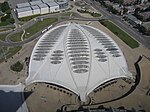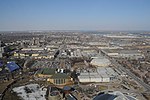Nicolaus Copernicus Monument, Montreal

The Nicolaus Copernicus Monument (French: Monument à Nicolas Copernic), a 1966 copy of Bertel Thorvaldsen's 1830 monument in Warsaw, is installed in outside the Rio Tinto Alcan Planetarium in Montreal's Space for Life, and was previously installed in Chaboillez Square, outside the Montreal Planetarium. The statue was originally displayed for Expo 67, and was relocated to its current location in 2013. Artist: Bertel Thorvaldsen (1770–1844), Danish sculptor Materials Statue: bronze Base: concrete Dimensions: Statue: 2.7 m × 1.1 m Base: 1.8 m × 1.5 m Manufacturing: Bronze: Lauritz Rasmussen, Denmark, posthumous draw from plaster molds and original made in 1966 under the supervision of Dr. Dyveke Helsted, Thorvaldsen Museum director Inaugurated in 1967, Montreal World's Fair Acquired by the City of Montreal: 1968.
Excerpt from the Wikipedia article Nicolaus Copernicus Monument, Montreal (License: CC BY-SA 3.0, Authors, Images).Nicolaus Copernicus Monument, Montreal
Avenue Pierre-De Coubertin, Montreal Mercier–Hochelaga-Maisonneuve
Geographical coordinates (GPS) Address Nearby Places Show on map
Geographical coordinates (GPS)
| Latitude | Longitude |
|---|---|
| N 45.56064 ° | E -73.54933 ° |
Address
Avenue Pierre-De Coubertin 4777
H1V 1B3 Montreal, Mercier–Hochelaga-Maisonneuve
Quebec, Canada
Open on Google Maps









